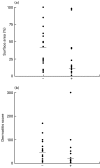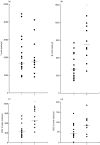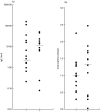Children with atopic dermatitis who carry toxin-positive Staphylococcus aureus strains have an expansion of blood CD5- B lymphocytes without an increase in disease severity
- PMID: 11529907
- PMCID: PMC1906122
- DOI: 10.1046/j.1365-2249.2001.01620.x
Children with atopic dermatitis who carry toxin-positive Staphylococcus aureus strains have an expansion of blood CD5- B lymphocytes without an increase in disease severity
Abstract
Toxin-positive strains of Staphylococcus aureus (T + S. aureus) are present on the skin of some but not all patients with atopic dermatitis. Many staphylococcal toxins are superantigens, which can stimulate the immune response and thus may potentially lead to the very high levels of IgE characteristic of this condition, as well as exacerbating the clinical disease. The aim of this study was to determine whether the presence of T + S. aureus on the skin of children with atopic dermatitis was associated with in vivo evidence of a heightened humoral immune response, higher IgE levels and more severe clinical disease. Toxin gene expression in S. aureus isolated from the eczematous lesions of 28 children with atopic dermatitis was assessed by PCR. Clinical and immune data were also collected from this cohort. Thirteen of the 28 children (46%) were colonized with T + S. aureus strains. The presence of T + S. aureus was associated with a significant expansion in peripheral blood CD5- B cells (P = 0.01), and the more toxin types identified the greater the B-cell expansion (P = 0.002). However, in this cohort of children with atopic dermatitis, despite th in vivo expansion of B cells in children harbouring T + S. aureus, there was no associated increase in IgE levels or in clinical disease severity scores.
Figures



References
-
- Marrack P, Kappler J. The Staphylococcal enterotoxins and their relatives. Science. 1990;248:705–11. - PubMed
-
- Kotzin BL, Leung DY, Kappler J, Marrack P. Superantigens and their potential role in human disease. Adv Immunol. 1993;54:99–166. - PubMed
-
- Schlievert PM. Role of superantigens in human disease. J Infect Dis. 1993;167:997–1002. - PubMed
-
- Leung DY. Atopic dermatitis: the skin as a window into the pathogenesis of chronic allergic diseases. J Allergy Clin Immunol. 1995;96:302–18. - PubMed
-
- Hoeger PH, Lenz W, Boutonier A, Fournier JM. Staphylococcal skin colonization in children with atopic dermatitis: prevalence, persistence, and transmission of toxigenic and nontoxigenic strains. J Infect Dis. 1992;165:1064–8. - PubMed
MeSH terms
Substances
LinkOut - more resources
Full Text Sources

